ITECH1100 Assignment: Virtual Reality and Aerospace Industry Report
VerifiedAdded on 2023/01/19
|9
|1696
|61
Report
AI Summary
This report provides a comprehensive analysis of the impact of Virtual Reality (VR) on the Aerospace Industry. It explores VR's applications in training, manufacturing, and decision-making processes, emphasizing its potential to enhance efficiency and safety. The report delves into the current state of the aerospace industry, highlighting the need for advanced training methods and innovative technologies. It examines how VR can simulate real-world scenarios, allowing pilots, flight attendants, and manufacturing workers to practice in a safe and controlled environment. The report also addresses the ethical considerations and disruptive potential of VR, including its impact on regulations and the workforce. It includes figures and references. Overall, the report concludes that VR has the potential to significantly transform the aerospace industry, making it safer, more efficient, and more innovative. It also suggests that VR can be used for training and decision making.
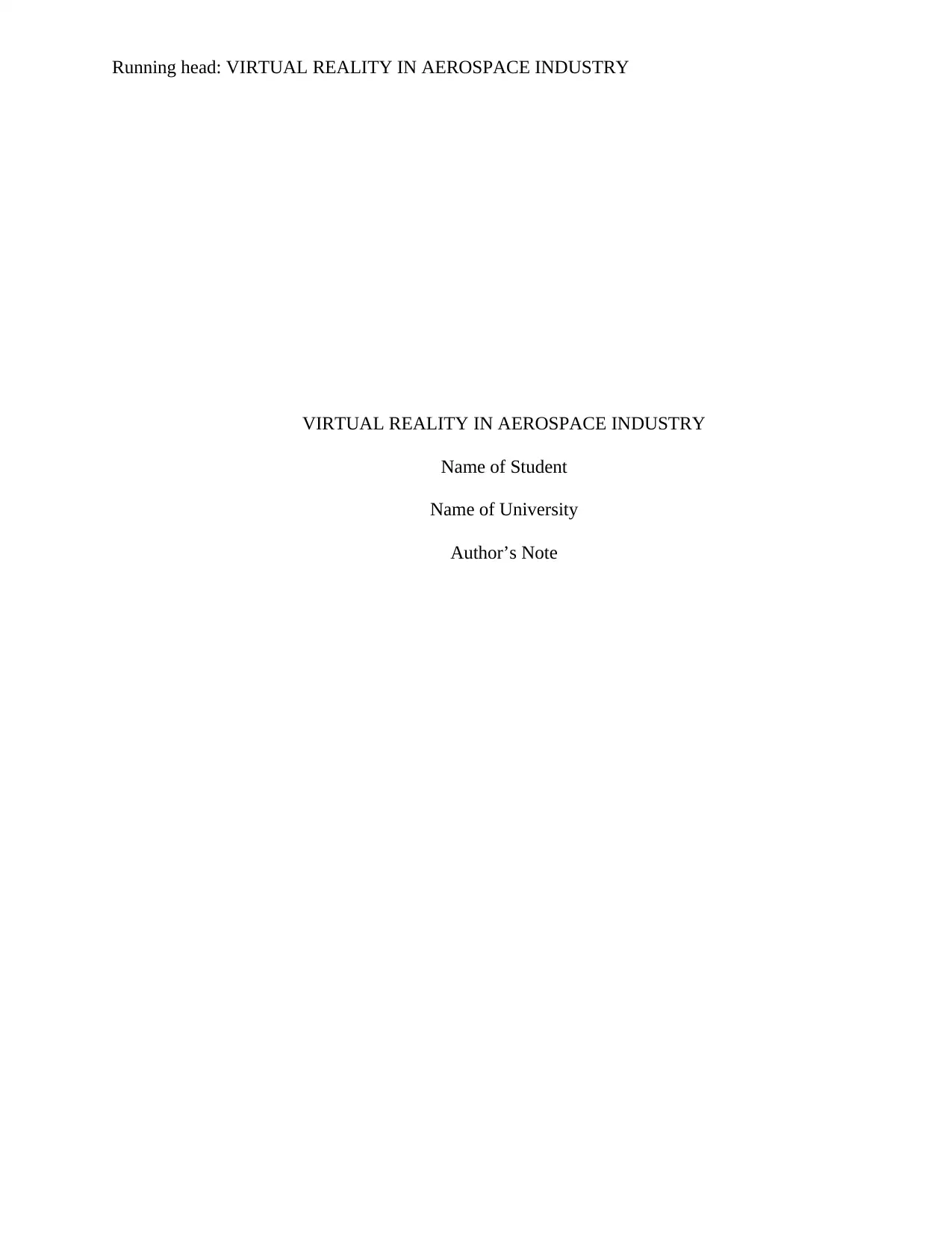
Running head: VIRTUAL REALITY IN AEROSPACE INDUSTRY
VIRTUAL REALITY IN AEROSPACE INDUSTRY
Name of Student
Name of University
Author’s Note
VIRTUAL REALITY IN AEROSPACE INDUSTRY
Name of Student
Name of University
Author’s Note
Paraphrase This Document
Need a fresh take? Get an instant paraphrase of this document with our AI Paraphraser
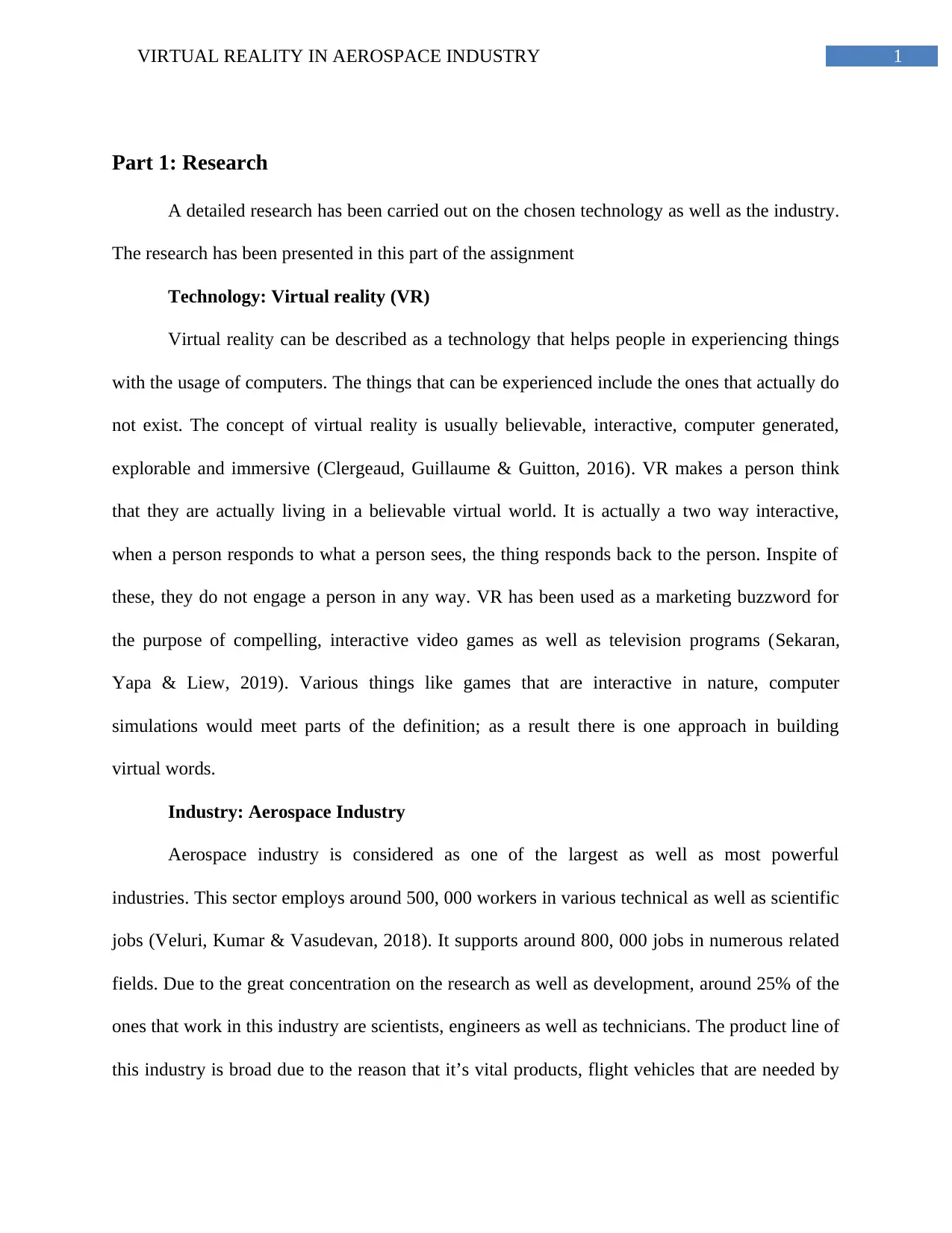
1VIRTUAL REALITY IN AEROSPACE INDUSTRY
Part 1: Research
A detailed research has been carried out on the chosen technology as well as the industry.
The research has been presented in this part of the assignment
Technology: Virtual reality (VR)
Virtual reality can be described as a technology that helps people in experiencing things
with the usage of computers. The things that can be experienced include the ones that actually do
not exist. The concept of virtual reality is usually believable, interactive, computer generated,
explorable and immersive (Clergeaud, Guillaume & Guitton, 2016). VR makes a person think
that they are actually living in a believable virtual world. It is actually a two way interactive,
when a person responds to what a person sees, the thing responds back to the person. Inspite of
these, they do not engage a person in any way. VR has been used as a marketing buzzword for
the purpose of compelling, interactive video games as well as television programs (Sekaran,
Yapa & Liew, 2019). Various things like games that are interactive in nature, computer
simulations would meet parts of the definition; as a result there is one approach in building
virtual words.
Industry: Aerospace Industry
Aerospace industry is considered as one of the largest as well as most powerful
industries. This sector employs around 500, 000 workers in various technical as well as scientific
jobs (Veluri, Kumar & Vasudevan, 2018). It supports around 800, 000 jobs in numerous related
fields. Due to the great concentration on the research as well as development, around 25% of the
ones that work in this industry are scientists, engineers as well as technicians. The product line of
this industry is broad due to the reason that it’s vital products, flight vehicles that are needed by
Part 1: Research
A detailed research has been carried out on the chosen technology as well as the industry.
The research has been presented in this part of the assignment
Technology: Virtual reality (VR)
Virtual reality can be described as a technology that helps people in experiencing things
with the usage of computers. The things that can be experienced include the ones that actually do
not exist. The concept of virtual reality is usually believable, interactive, computer generated,
explorable and immersive (Clergeaud, Guillaume & Guitton, 2016). VR makes a person think
that they are actually living in a believable virtual world. It is actually a two way interactive,
when a person responds to what a person sees, the thing responds back to the person. Inspite of
these, they do not engage a person in any way. VR has been used as a marketing buzzword for
the purpose of compelling, interactive video games as well as television programs (Sekaran,
Yapa & Liew, 2019). Various things like games that are interactive in nature, computer
simulations would meet parts of the definition; as a result there is one approach in building
virtual words.
Industry: Aerospace Industry
Aerospace industry is considered as one of the largest as well as most powerful
industries. This sector employs around 500, 000 workers in various technical as well as scientific
jobs (Veluri, Kumar & Vasudevan, 2018). It supports around 800, 000 jobs in numerous related
fields. Due to the great concentration on the research as well as development, around 25% of the
ones that work in this industry are scientists, engineers as well as technicians. The product line of
this industry is broad due to the reason that it’s vital products, flight vehicles that are needed by
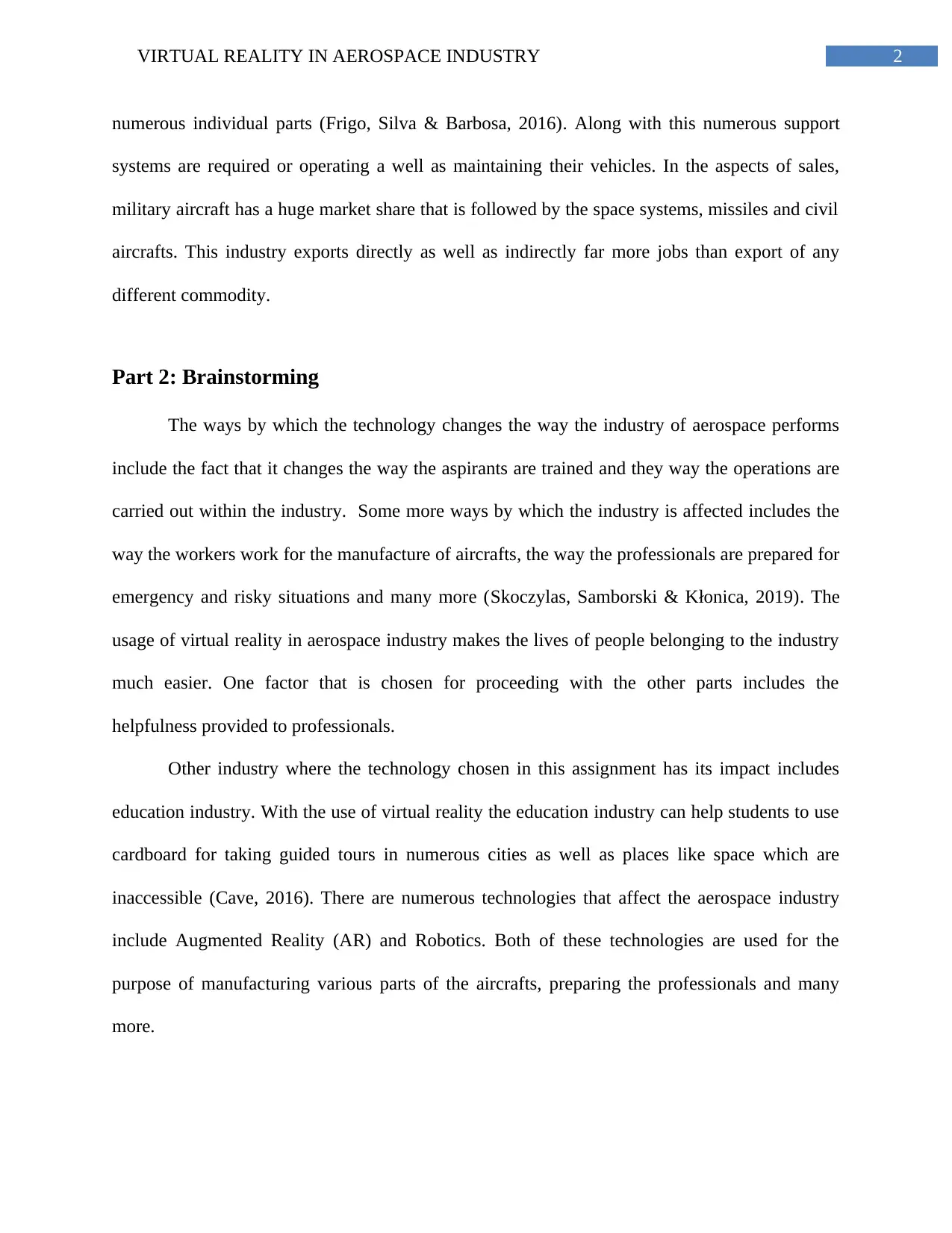
2VIRTUAL REALITY IN AEROSPACE INDUSTRY
numerous individual parts (Frigo, Silva & Barbosa, 2016). Along with this numerous support
systems are required or operating a well as maintaining their vehicles. In the aspects of sales,
military aircraft has a huge market share that is followed by the space systems, missiles and civil
aircrafts. This industry exports directly as well as indirectly far more jobs than export of any
different commodity.
Part 2: Brainstorming
The ways by which the technology changes the way the industry of aerospace performs
include the fact that it changes the way the aspirants are trained and they way the operations are
carried out within the industry. Some more ways by which the industry is affected includes the
way the workers work for the manufacture of aircrafts, the way the professionals are prepared for
emergency and risky situations and many more (Skoczylas, Samborski & Kłonica, 2019). The
usage of virtual reality in aerospace industry makes the lives of people belonging to the industry
much easier. One factor that is chosen for proceeding with the other parts includes the
helpfulness provided to professionals.
Other industry where the technology chosen in this assignment has its impact includes
education industry. With the use of virtual reality the education industry can help students to use
cardboard for taking guided tours in numerous cities as well as places like space which are
inaccessible (Cave, 2016). There are numerous technologies that affect the aerospace industry
include Augmented Reality (AR) and Robotics. Both of these technologies are used for the
purpose of manufacturing various parts of the aircrafts, preparing the professionals and many
more.
numerous individual parts (Frigo, Silva & Barbosa, 2016). Along with this numerous support
systems are required or operating a well as maintaining their vehicles. In the aspects of sales,
military aircraft has a huge market share that is followed by the space systems, missiles and civil
aircrafts. This industry exports directly as well as indirectly far more jobs than export of any
different commodity.
Part 2: Brainstorming
The ways by which the technology changes the way the industry of aerospace performs
include the fact that it changes the way the aspirants are trained and they way the operations are
carried out within the industry. Some more ways by which the industry is affected includes the
way the workers work for the manufacture of aircrafts, the way the professionals are prepared for
emergency and risky situations and many more (Skoczylas, Samborski & Kłonica, 2019). The
usage of virtual reality in aerospace industry makes the lives of people belonging to the industry
much easier. One factor that is chosen for proceeding with the other parts includes the
helpfulness provided to professionals.
Other industry where the technology chosen in this assignment has its impact includes
education industry. With the use of virtual reality the education industry can help students to use
cardboard for taking guided tours in numerous cities as well as places like space which are
inaccessible (Cave, 2016). There are numerous technologies that affect the aerospace industry
include Augmented Reality (AR) and Robotics. Both of these technologies are used for the
purpose of manufacturing various parts of the aircrafts, preparing the professionals and many
more.
⊘ This is a preview!⊘
Do you want full access?
Subscribe today to unlock all pages.

Trusted by 1+ million students worldwide
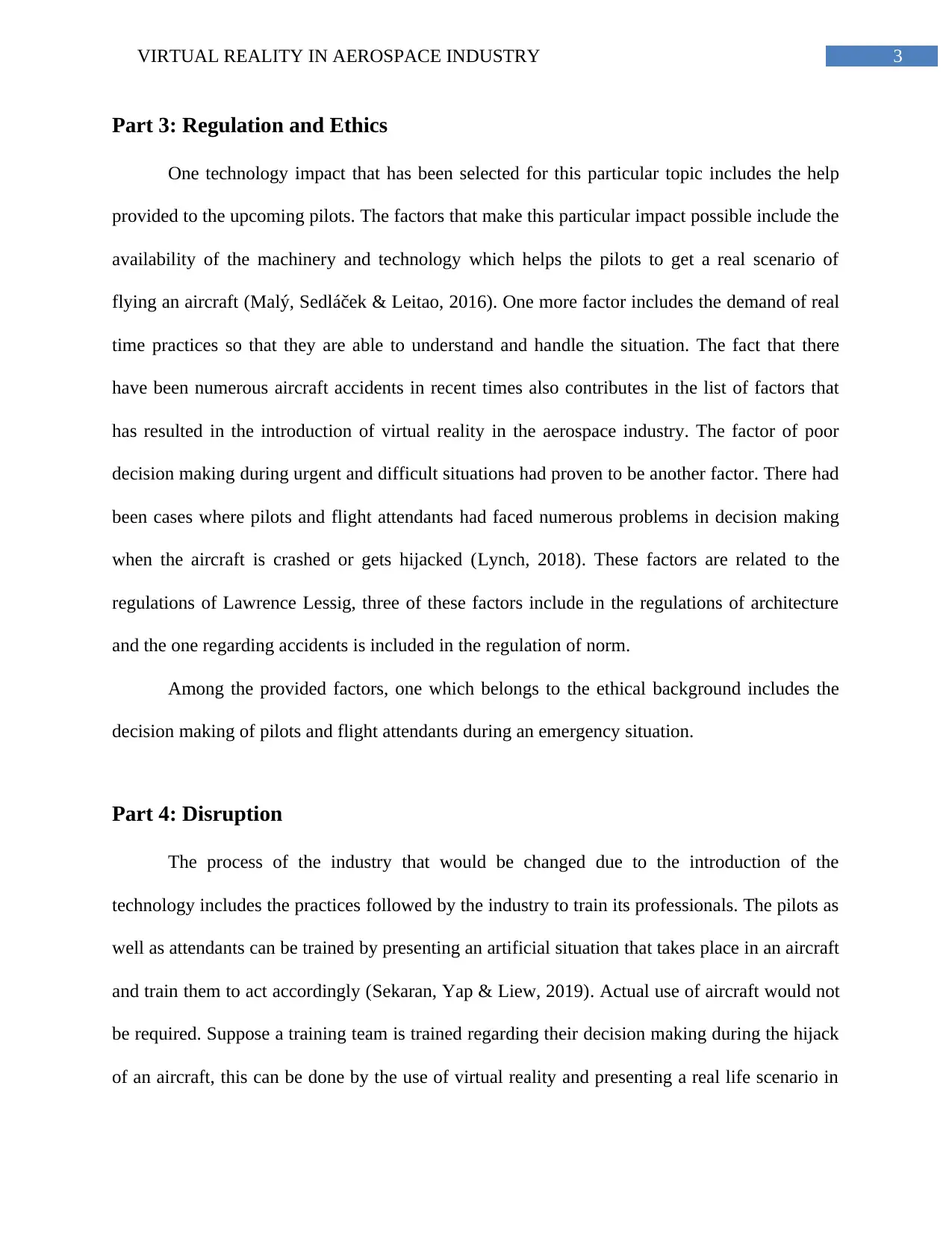
3VIRTUAL REALITY IN AEROSPACE INDUSTRY
Part 3: Regulation and Ethics
One technology impact that has been selected for this particular topic includes the help
provided to the upcoming pilots. The factors that make this particular impact possible include the
availability of the machinery and technology which helps the pilots to get a real scenario of
flying an aircraft (Malý, Sedláček & Leitao, 2016). One more factor includes the demand of real
time practices so that they are able to understand and handle the situation. The fact that there
have been numerous aircraft accidents in recent times also contributes in the list of factors that
has resulted in the introduction of virtual reality in the aerospace industry. The factor of poor
decision making during urgent and difficult situations had proven to be another factor. There had
been cases where pilots and flight attendants had faced numerous problems in decision making
when the aircraft is crashed or gets hijacked (Lynch, 2018). These factors are related to the
regulations of Lawrence Lessig, three of these factors include in the regulations of architecture
and the one regarding accidents is included in the regulation of norm.
Among the provided factors, one which belongs to the ethical background includes the
decision making of pilots and flight attendants during an emergency situation.
Part 4: Disruption
The process of the industry that would be changed due to the introduction of the
technology includes the practices followed by the industry to train its professionals. The pilots as
well as attendants can be trained by presenting an artificial situation that takes place in an aircraft
and train them to act accordingly (Sekaran, Yap & Liew, 2019). Actual use of aircraft would not
be required. Suppose a training team is trained regarding their decision making during the hijack
of an aircraft, this can be done by the use of virtual reality and presenting a real life scenario in
Part 3: Regulation and Ethics
One technology impact that has been selected for this particular topic includes the help
provided to the upcoming pilots. The factors that make this particular impact possible include the
availability of the machinery and technology which helps the pilots to get a real scenario of
flying an aircraft (Malý, Sedláček & Leitao, 2016). One more factor includes the demand of real
time practices so that they are able to understand and handle the situation. The fact that there
have been numerous aircraft accidents in recent times also contributes in the list of factors that
has resulted in the introduction of virtual reality in the aerospace industry. The factor of poor
decision making during urgent and difficult situations had proven to be another factor. There had
been cases where pilots and flight attendants had faced numerous problems in decision making
when the aircraft is crashed or gets hijacked (Lynch, 2018). These factors are related to the
regulations of Lawrence Lessig, three of these factors include in the regulations of architecture
and the one regarding accidents is included in the regulation of norm.
Among the provided factors, one which belongs to the ethical background includes the
decision making of pilots and flight attendants during an emergency situation.
Part 4: Disruption
The process of the industry that would be changed due to the introduction of the
technology includes the practices followed by the industry to train its professionals. The pilots as
well as attendants can be trained by presenting an artificial situation that takes place in an aircraft
and train them to act accordingly (Sekaran, Yap & Liew, 2019). Actual use of aircraft would not
be required. Suppose a training team is trained regarding their decision making during the hijack
of an aircraft, this can be done by the use of virtual reality and presenting a real life scenario in
Paraphrase This Document
Need a fresh take? Get an instant paraphrase of this document with our AI Paraphraser
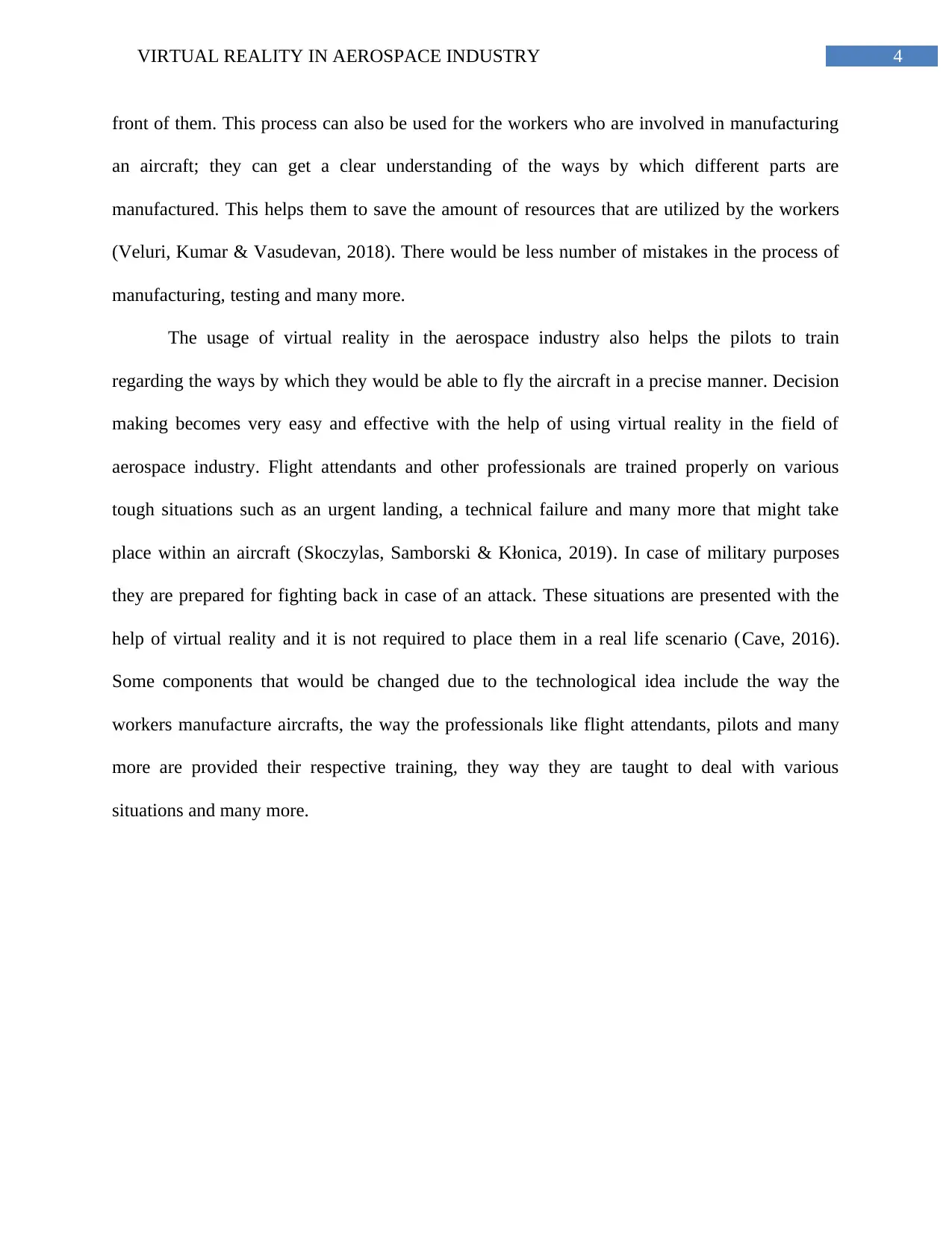
4VIRTUAL REALITY IN AEROSPACE INDUSTRY
front of them. This process can also be used for the workers who are involved in manufacturing
an aircraft; they can get a clear understanding of the ways by which different parts are
manufactured. This helps them to save the amount of resources that are utilized by the workers
(Veluri, Kumar & Vasudevan, 2018). There would be less number of mistakes in the process of
manufacturing, testing and many more.
The usage of virtual reality in the aerospace industry also helps the pilots to train
regarding the ways by which they would be able to fly the aircraft in a precise manner. Decision
making becomes very easy and effective with the help of using virtual reality in the field of
aerospace industry. Flight attendants and other professionals are trained properly on various
tough situations such as an urgent landing, a technical failure and many more that might take
place within an aircraft (Skoczylas, Samborski & Kłonica, 2019). In case of military purposes
they are prepared for fighting back in case of an attack. These situations are presented with the
help of virtual reality and it is not required to place them in a real life scenario (Cave, 2016).
Some components that would be changed due to the technological idea include the way the
workers manufacture aircrafts, the way the professionals like flight attendants, pilots and many
more are provided their respective training, they way they are taught to deal with various
situations and many more.
front of them. This process can also be used for the workers who are involved in manufacturing
an aircraft; they can get a clear understanding of the ways by which different parts are
manufactured. This helps them to save the amount of resources that are utilized by the workers
(Veluri, Kumar & Vasudevan, 2018). There would be less number of mistakes in the process of
manufacturing, testing and many more.
The usage of virtual reality in the aerospace industry also helps the pilots to train
regarding the ways by which they would be able to fly the aircraft in a precise manner. Decision
making becomes very easy and effective with the help of using virtual reality in the field of
aerospace industry. Flight attendants and other professionals are trained properly on various
tough situations such as an urgent landing, a technical failure and many more that might take
place within an aircraft (Skoczylas, Samborski & Kłonica, 2019). In case of military purposes
they are prepared for fighting back in case of an attack. These situations are presented with the
help of virtual reality and it is not required to place them in a real life scenario (Cave, 2016).
Some components that would be changed due to the technological idea include the way the
workers manufacture aircrafts, the way the professionals like flight attendants, pilots and many
more are provided their respective training, they way they are taught to deal with various
situations and many more.
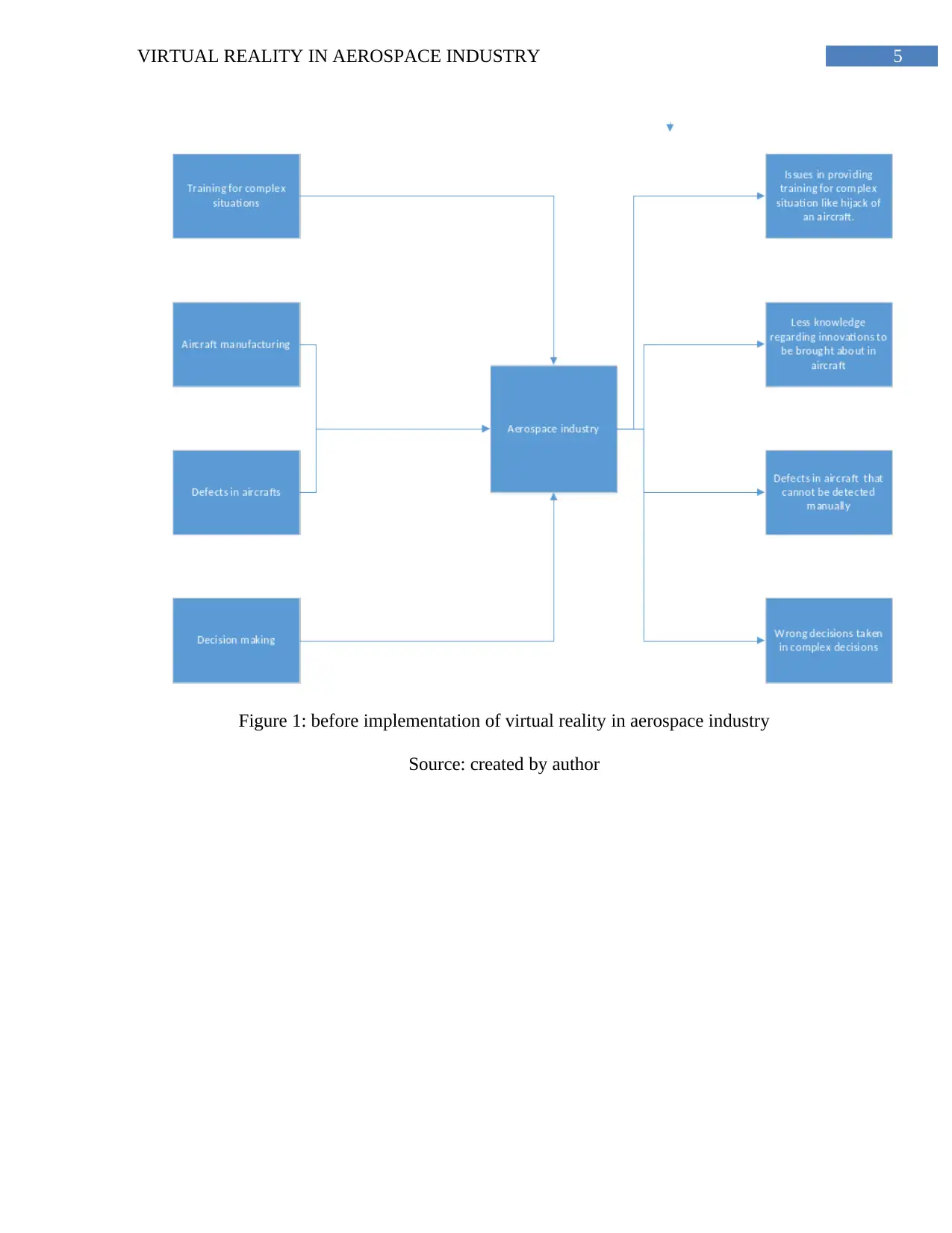
5VIRTUAL REALITY IN AEROSPACE INDUSTRY
Figure 1: before implementation of virtual reality in aerospace industry
Source: created by author
Figure 1: before implementation of virtual reality in aerospace industry
Source: created by author
⊘ This is a preview!⊘
Do you want full access?
Subscribe today to unlock all pages.

Trusted by 1+ million students worldwide
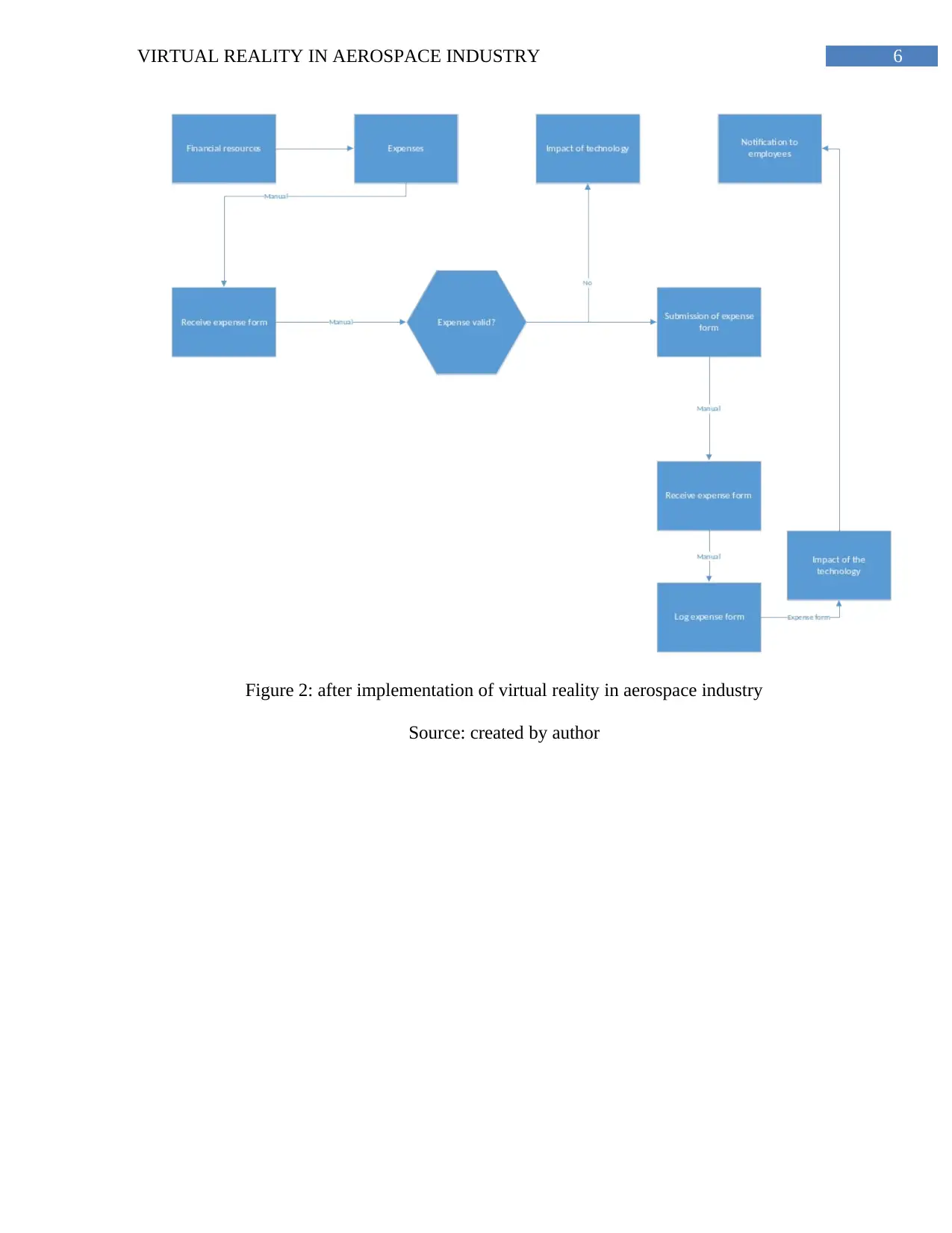
6VIRTUAL REALITY IN AEROSPACE INDUSTRY
Figure 2: after implementation of virtual reality in aerospace industry
Source: created by author
Figure 2: after implementation of virtual reality in aerospace industry
Source: created by author
Paraphrase This Document
Need a fresh take? Get an instant paraphrase of this document with our AI Paraphraser
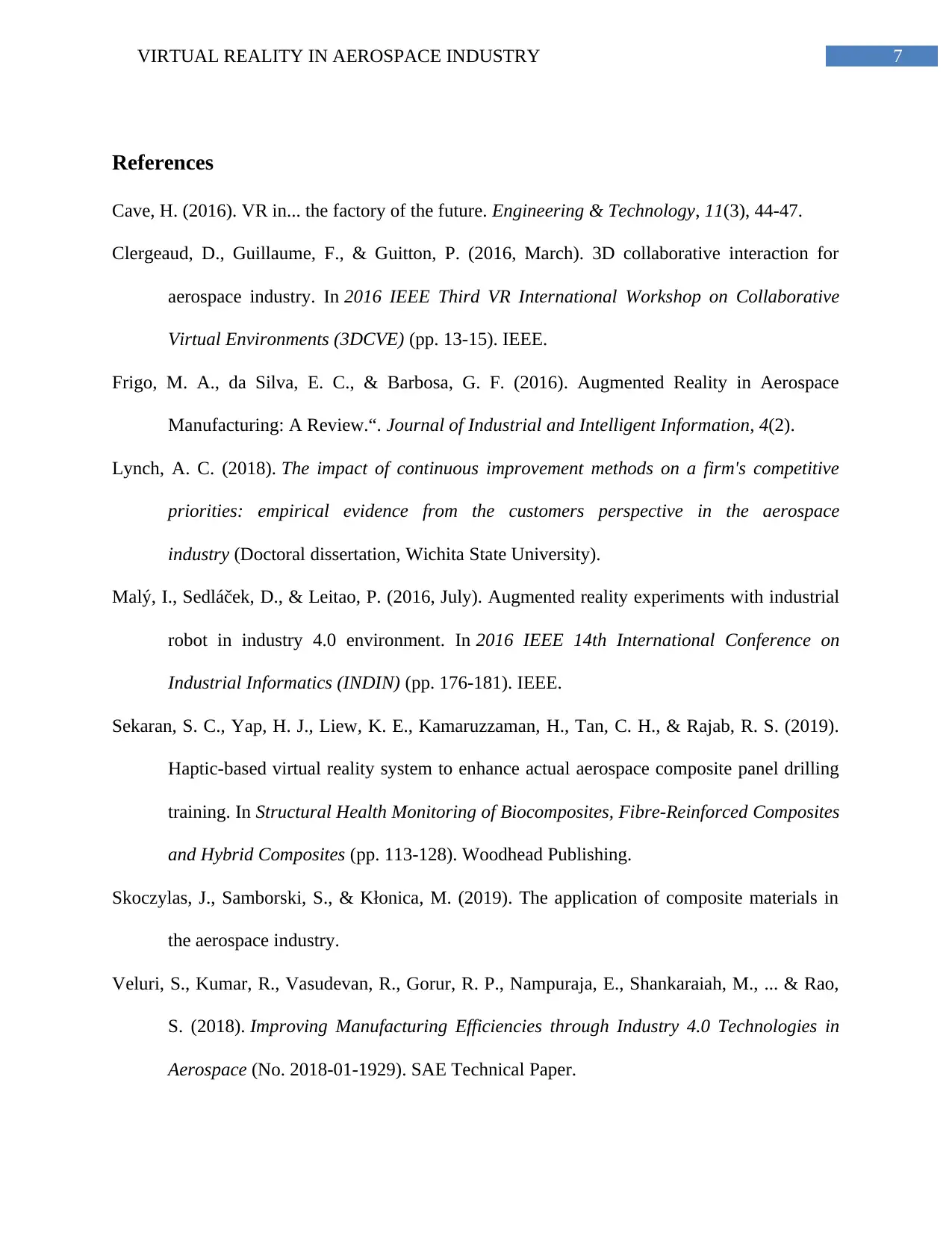
7VIRTUAL REALITY IN AEROSPACE INDUSTRY
References
Cave, H. (2016). VR in... the factory of the future. Engineering & Technology, 11(3), 44-47.
Clergeaud, D., Guillaume, F., & Guitton, P. (2016, March). 3D collaborative interaction for
aerospace industry. In 2016 IEEE Third VR International Workshop on Collaborative
Virtual Environments (3DCVE) (pp. 13-15). IEEE.
Frigo, M. A., da Silva, E. C., & Barbosa, G. F. (2016). Augmented Reality in Aerospace
Manufacturing: A Review.“. Journal of Industrial and Intelligent Information, 4(2).
Lynch, A. C. (2018). The impact of continuous improvement methods on a firm's competitive
priorities: empirical evidence from the customers perspective in the aerospace
industry (Doctoral dissertation, Wichita State University).
Malý, I., Sedláček, D., & Leitao, P. (2016, July). Augmented reality experiments with industrial
robot in industry 4.0 environment. In 2016 IEEE 14th International Conference on
Industrial Informatics (INDIN) (pp. 176-181). IEEE.
Sekaran, S. C., Yap, H. J., Liew, K. E., Kamaruzzaman, H., Tan, C. H., & Rajab, R. S. (2019).
Haptic-based virtual reality system to enhance actual aerospace composite panel drilling
training. In Structural Health Monitoring of Biocomposites, Fibre-Reinforced Composites
and Hybrid Composites (pp. 113-128). Woodhead Publishing.
Skoczylas, J., Samborski, S., & Kłonica, M. (2019). The application of composite materials in
the aerospace industry.
Veluri, S., Kumar, R., Vasudevan, R., Gorur, R. P., Nampuraja, E., Shankaraiah, M., ... & Rao,
S. (2018). Improving Manufacturing Efficiencies through Industry 4.0 Technologies in
Aerospace (No. 2018-01-1929). SAE Technical Paper.
References
Cave, H. (2016). VR in... the factory of the future. Engineering & Technology, 11(3), 44-47.
Clergeaud, D., Guillaume, F., & Guitton, P. (2016, March). 3D collaborative interaction for
aerospace industry. In 2016 IEEE Third VR International Workshop on Collaborative
Virtual Environments (3DCVE) (pp. 13-15). IEEE.
Frigo, M. A., da Silva, E. C., & Barbosa, G. F. (2016). Augmented Reality in Aerospace
Manufacturing: A Review.“. Journal of Industrial and Intelligent Information, 4(2).
Lynch, A. C. (2018). The impact of continuous improvement methods on a firm's competitive
priorities: empirical evidence from the customers perspective in the aerospace
industry (Doctoral dissertation, Wichita State University).
Malý, I., Sedláček, D., & Leitao, P. (2016, July). Augmented reality experiments with industrial
robot in industry 4.0 environment. In 2016 IEEE 14th International Conference on
Industrial Informatics (INDIN) (pp. 176-181). IEEE.
Sekaran, S. C., Yap, H. J., Liew, K. E., Kamaruzzaman, H., Tan, C. H., & Rajab, R. S. (2019).
Haptic-based virtual reality system to enhance actual aerospace composite panel drilling
training. In Structural Health Monitoring of Biocomposites, Fibre-Reinforced Composites
and Hybrid Composites (pp. 113-128). Woodhead Publishing.
Skoczylas, J., Samborski, S., & Kłonica, M. (2019). The application of composite materials in
the aerospace industry.
Veluri, S., Kumar, R., Vasudevan, R., Gorur, R. P., Nampuraja, E., Shankaraiah, M., ... & Rao,
S. (2018). Improving Manufacturing Efficiencies through Industry 4.0 Technologies in
Aerospace (No. 2018-01-1929). SAE Technical Paper.

8VIRTUAL REALITY IN AEROSPACE INDUSTRY
⊘ This is a preview!⊘
Do you want full access?
Subscribe today to unlock all pages.

Trusted by 1+ million students worldwide
1 out of 9
Related Documents
Your All-in-One AI-Powered Toolkit for Academic Success.
+13062052269
info@desklib.com
Available 24*7 on WhatsApp / Email
![[object Object]](/_next/static/media/star-bottom.7253800d.svg)
Unlock your academic potential
Copyright © 2020–2025 A2Z Services. All Rights Reserved. Developed and managed by ZUCOL.





